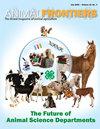地中海地区羊肉生产的当前战略
IF 3.2
2区 农林科学
Q1 AGRICULTURE, DAIRY & ANIMAL SCIENCE
引用次数: 5
摘要
养羊在世界各地都很普遍。它的特点可以适应其他农业部门无法适应的地区和资源;因此,应考虑其经济影响(de Rancourt, 2007)。对贫困地区的人口具有救助作用,对防止土壤沙漠化和维持生态平衡具有重要作用。尽管近年来发达国家的人口普查和消费都出现了倒退,但仍有必要继续研究羊肉生产,以提供公认质量的产品。在西班牙,与大多数地中海国家一样,绵羊行业的发展导致农场盈利能力下降,代际不确定性高,以及一些地区放弃养殖后的担忧(bernusamas et al., 2011)。在地中海地区,消费者比其他任何地方都更重视以精料喂养的轻质羔羊(Beriain等人,2000年),这被认为是高质量的产品(Boyazoglu和Mohrand-Ferh, 2001年)。预期权重的任何偏差都会对可接受性产生负面影响,即使区域内偏好存在差异(Sañudo et al., 1996)。事实上,在西班牙东北部的阿拉贡地区,屠宰的羔羊中有76%的胴体重量低于13公斤(占全国的68%),因此属于轻型羔羊(MAGRAMA, 2016)。地中海地区羊肉生产的当前战略本文章由计算机程序翻译,如有差异,请以英文原文为准。
Current strategies in lamb production in Mediterranean areas
Sheep farming is widespread worldwide. Its characteristics can adapt to areas and resources where other farming sectors could not; therefore, its economic impact should be considered (de Rancourt, 2007). Also, it aids populations in disadvantaged areas and plays an important role preventing soil desertification and maintaining the biological balance. Although in recent years, both census and consumption setbacks in developed countries have been observed, it is necessary to continue studies on lamb production to offer products of recognized quality. In Spain, as in most Mediterranean countries, evolution of the sheep sector has led to a decline in profitability of farms, high generational uncertainty, and concern following the abandonment of farming in some areas (Bernués et al., 2011a). In the Mediterranean area, more than anywhere else, consumers value the type of light lamb fed on concentrates (Beriain et al., 2000), which is considered a high quality product (Boyazoglu and Mohrand-Ferh, 2001). Any deviation in the expected weight has a negative impact on the acceptability, even if there are intraregional variations in preferences (Sañudo et al., 1996). In fact, 76% of the lambs slaughtered in Aragon, a region in northeastern Spain, have carcass weights of less than 13 kg (68% in the whole country) and, therefore, are under the light lamb designation (MAGRAMA, 2016). Current strategies in lamb production in Mediterranean areas
求助全文
通过发布文献求助,成功后即可免费获取论文全文。
去求助
来源期刊

Animal Frontiers
Veterinary-Food Animals
CiteScore
6.50
自引率
5.60%
发文量
74
期刊介绍:
Animal Frontiers is the official journal of the following globally active professional animal science societies:
ASAS, the American Society of Animal Science
CSAS, the Canadian Society of Animal Science
EAAP, the European Federation of Animal Science
AMSA, the American Meat Science Association
These organizations are dedicated to the advancement and dissemination of science-based knowledge concerning animal agriculture. Animal Frontiers provides a novel forum for innovative and timely perspectives that have relevance to understanding the complex dynamics at work through animal agriculture. Animal Frontiers publishes discussion and position papers that present several international perspectives on the status of high-impact, global issues in animal agriculture. Every issue will explore a theme of broad and current interest within animal science and animal agriculture.
 求助内容:
求助内容: 应助结果提醒方式:
应助结果提醒方式:


